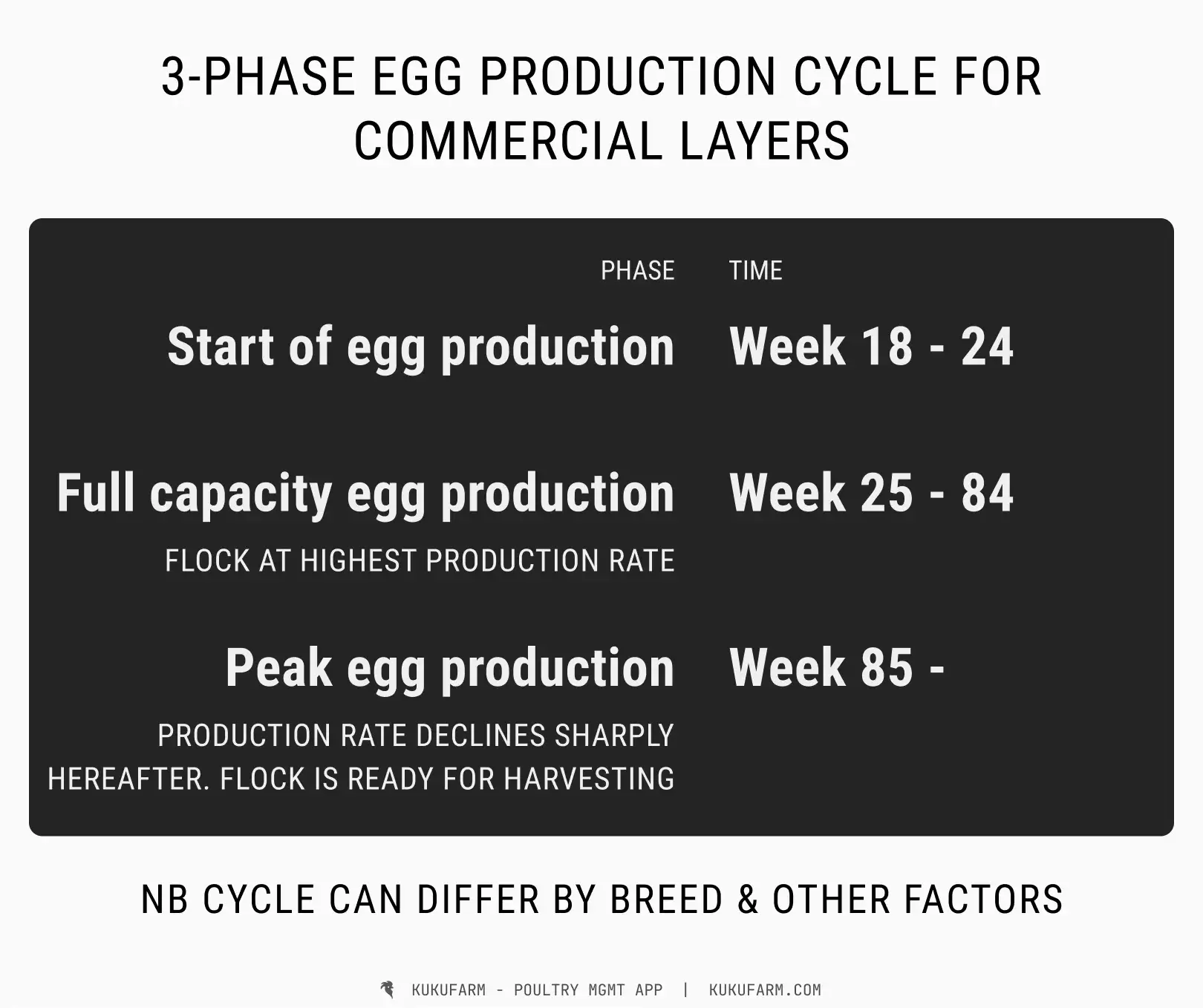Chicken have a 3-phase egg production cycle. Essentially, understanding a chicken’s egg production cycle enables you to answer the following questions:
- When will your layers flock start to lay eggs,
- When will their egg production peak, and
- When will they stop laying eggs?
For starters, as a layers poultry farmer you want to know the answers to these questions. In addition, you can use them as a benchmark to determine the suitability and viability of your layers birds.
Egg production cycle
A layers’ flock egg production cycle consists of 3 phases:
- Start of egg production
- Full egg production capacity
- Peak egg production
Below is a generic egg production cycle

As a rule of thumb, especially for commercial farmers, you should be able to obtain this information from your flock supplier or certified poultry vet. Moreover, being aware of a flock’s egg production cycle can help you plan flock management activities and anticipate farm management in advance.
3 Phases of egg production cycle
A flock’s egg production cycle is determined by its breed among other factors.
For the purpose of this article, below is a generic poultry egg production cycle. Since poultry breeds have different egg cycles, obtain your flock’s egg production cycle information from your flock supplier.
1. Start of egg production
Common knowledge has it that most layers chicken start laying eggs at the age of 16 – 24 weeks. However, even in a single flock, not all birds start laying eggs on the same day or week.
Dual purpose and multi purpose hens usually start laying eggs much later in comparison to their hybrid and commercial counterparts.

2. Full egg production capacity
If your flock egg production cycle begins at week 16 – 24, then you can expect egg production to reach highest capacity for your flock from week 25.
Full egg production capacity simply means a period when layers birds are at their highest egg production. However, keep in mind that in a single flock, not all birds lay eggs every day. Some of the breeds with the highest egg production rates can achieve an egg production rate in the 90 percentages, in suitable conditions.
Egg production rate can be determined by factors such as nutrition, weather, day light duration, and suitability of coop conditions.
| Egg production phase | Duration |
|---|---|
| Start of egg production | Week 18 – 24 |
| Full egg production capacity (Flock in its highest production capacity) | Week 25 – 84 |
| Peak egg production (Egg production decline sharply hereafter) | Week 85 – |
On average commercial hybrid layers flocks are in full egg production capacity from week 25 to week 84. After week 84, a flock enters peak egg production
3. Peak egg production
A healthy layers flock can produce eggs for 2 to 3 years, depending on their breed, and under suitable conditions. Dual purpose breeds can lay eggs for much longer.
However, once a flock is beyond its high egg production phase, it enters peak egg production. In peak egg production, a drop in egg production can be expected.
A flock’s egg production does not usually come to an end suddenly. Instead, egg production continues to drop gradually hereafter, as birds age. For commercial layers flocks, birds are usually harvested as soon as they reach peak egg production, since their declining egg production is no longer financially viable.
If you would like to track the flocks’ egg production rate, we think Kukufarm is the app for the job.
Kukufarm – poultry management app



Key takeaways
- For most poultry breeds, egg production starts between week 18 – 24 of age
- Egg production reaches full capacity from week 25 and continues for the first year of egg production, for some commercial breeds upto week 84
- The egg production drops gradually after peak production phase
- Obtain precise egg production cycle information from your flock supplier or certified poultry vet
- Knowing your flock’s egg production cycle will help you anticipate and plan flock and farm management activities in advance



